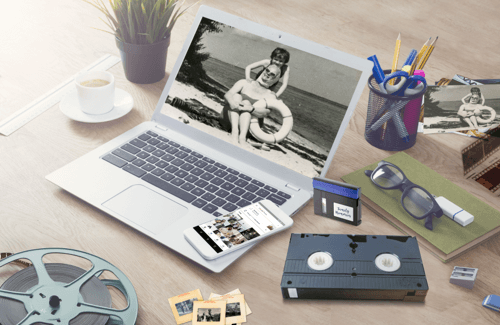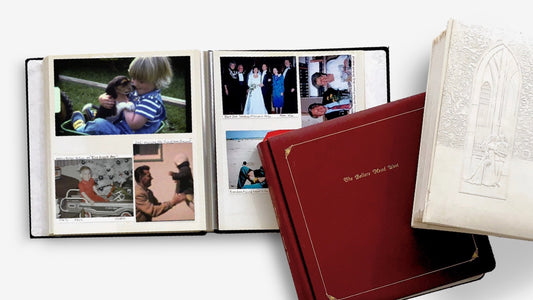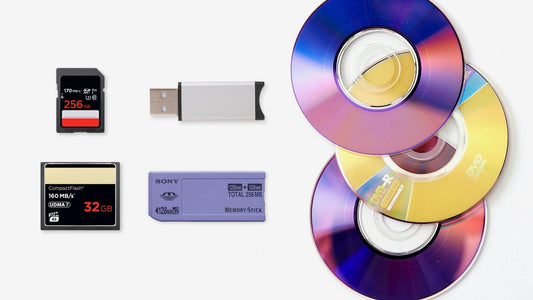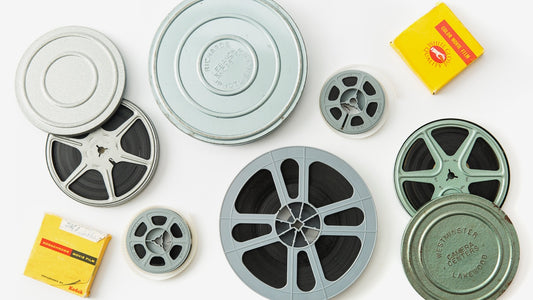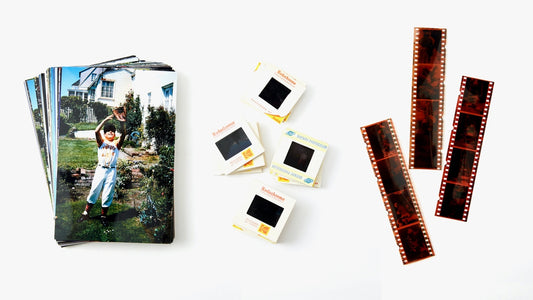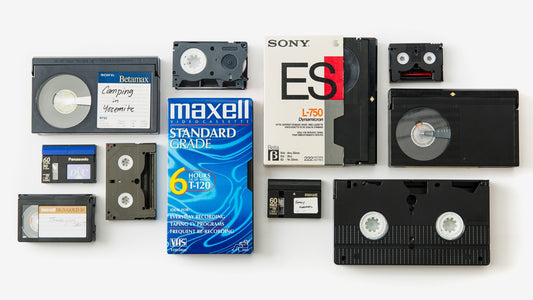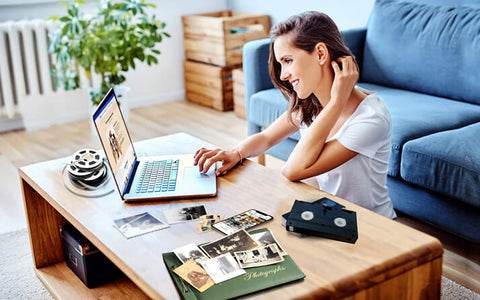Your wedding video, your child's first steps, that hilarious family vacation—so many precious memories are likely stuck on old VHS tapes. The problem is, those tapes are fading. Time, humidity, and even just playing them can damage the fragile film, putting your irreplaceable moments at risk. The best way to protect them is to digitize VCR tapes. This guide provides a clear, step-by-step plan for preserving your home movies. We'll cover everything from DIY options and professional services to the essential equipment, ensuring your memories are safe for generations to come.
Key Takeaways
- Digitizing VHS tapes protects irreplaceable memories from damage and deterioration. This ensures your home videos remain viewable and enjoyable for generations to come.
- DIY digitization offers a budget-friendly approach, while professional services prioritize quality and convenience. Consider your technical skills, budget, and the importance of your videos when choosing a method.
- Safeguarding your digital videos is essential for long-term access. Back up your files on external hard drives or cloud storage, and choose versatile formats like MP4 for easy sharing and compatibility.
What Does It Mean to Digitize a VCR Tape?
Digitizing your VHS tapes means converting those old movies and home videos into digital files. Think of it like taking a physical photo and creating a digital copy you can store on your computer or phone. This process transforms the analog information on your magnetic tapes into a digital format, making it easier to watch and share those precious memories. Instead of needing a VCR, you can view your videos on modern devices like laptops, smartphones, and smart TVs. YesVideo specializes in this type of conversion, offering services to help preserve your memories.
Why It's Time to Preserve Your VHS Memories
Those old VHS tapes hold a treasure trove of memories. Unfortunately, VHS tapes degrade over time. The magnetic tape can wear down, and the quality deteriorates, sometimes making videos unwatchable. Digitizing these tapes is like giving them a new lease on life, ensuring your memories are safe and accessible for years to come. Plus, finding a working VCR is becoming increasingly difficult! For more information on preserving analog media, check out this helpful blog post.
The Lifespan of a VHS Tape
VHS tapes weren't made to last forever. In fact, they can start to show significant signs of degradation after just 15 years. Factors like humidity, temperature swings, and even how often you play them can speed up this decay, causing the picture and sound quality to fade. As the experts at Kodak Digitizing note, "Old VHS tapes are slowly breaking down, especially after 15 years, causing your precious memories to fade away." This magnetic tape decay is an unavoidable part of the format's lifecycle, putting the home movies stored on them at risk over time.
This limited lifespan is why preservation is so critical. Legacybox further highlights the urgency, stating, "The tapes themselves start to break down after about 15 years, meaning your memories could be lost forever if not converted." This really drives home why it's so important to act sooner rather than later to protect those irreplaceable moments captured on tape. Every year that passes increases the chance of permanent damage, from fading colors and muffled audio to the tape itself becoming too brittle to play without snapping. It's a quiet process, but the risk to your memories is very real.
As you think about the best way to protect your home movies, remember that the clock is ticking on these old formats. The longer you wait, the greater the risk of losing those moments forever. Taking the step to transfer your VHS tapes to a modern digital format is the only way to stop this decay in its tracks. It secures those memories for good, making them easy to watch, share, and pass down to the next generation. This ensures your family's history can be enjoyed for many more years to come, safe from the physical limitations of aging tapes.
Choosing the Right Digital Format
Once digitized, your VHS tapes become digital video files compatible with today's technology. Common digital video formats include MP4, MOV, and AVI. These files are easily stored on your computer, an external hard drive, or in cloud storage services. You can also edit your digitized videos using video editing software. Trimming unwanted footage, adding captions, or enhancing video quality is all possible with user-friendly programs. This gives you the flexibility to create polished versions of your home movies or compile clips into highlight reels.
Top Reasons to Digitize Your VCR Tapes
Let's be honest, those old VCR tapes aren't getting any younger. Digitizing your tapes is more than just a trend; it's about safeguarding your memories for the future. There are several compelling reasons why you should consider this important step.
Stop Your Tapes from Fading Away
Think of your VCR tapes like any other physical item. Over time, they wear down. Things like heat, humidity, and even just playing them repeatedly can cause the magnetic tape inside to degrade, leading to fuzzy images, distorted sound, or even complete data loss. Digitizing creates a safe, permanent copy of your videos, protecting them from the inevitable effects of time. It's like giving your memories a fresh start.
Share Your Memories with Anyone, Anywhere
Remember the last time you wanted to watch an old home video? Did you have to dust off the VCR, find the right cables, and hope it still worked? Digitizing eliminates that hassle. With your videos in a digital format, you can easily watch them on your computer, phone, or tablet. Sharing digital videos with family and friends online is simple, or you can burn DVDs if you prefer a physical copy. No more rewinding or fast-forwarding – just instant access to your cherished moments.
Can Digitizing Improve Video Quality?
Now, it's important to be realistic about video quality. Digitizing won't magically transform a blurry home video into a high-definition masterpiece. The process creates a faithful copy of your original recording. However, choosing the right equipment and software can make a big difference. Using a high-quality capture device can ensure your digital videos are as clear and vibrant as possible, preserving the best version of your memories. Consider professional services like YesVideo for optimal results, as they utilize top-tier equipment for video transfer.
Your Checklist: What You Need to Digitize VCR Tapes
Ready to start your VHS digitization project? Here’s what you’ll need:
Finding the Right VCR or Playback Deck
First, you’ll need a working VCR. This might seem obvious, but it's important to have a reliable player that can handle your old tapes. If your VCR is broken, check online marketplaces or local thrift stores for replacements. You'll also need a computer (with or without a DVD drive) and an analog-to-digital converter to transfer your tapes to a digital format.
The Importance of S-Video Output
When you're choosing a VCR for your project, don't just grab the first one you find in the attic. The type of connection it uses can make a significant difference in your final video quality. For the best possible picture, look for a VCR that has an S-Video output. Unlike the standard yellow composite plug that most of us remember, an S-Video connection processes brightness and color signals separately. This technical detail translates into a noticeably sharper and cleaner image, which is crucial for preserving the fine details of your family’s most important moments.
To achieve the best results, seek out a high-quality VCR; models from brands like JVC or Panasonic are often recommended by video experts for their superior playback and S-Video capabilities. Pairing your VCR with a good analog-to-digital converter is just as important, as cheap, all-in-one converters can produce disappointing, low-quality files. Sourcing this specific gear can feel like a technical treasure hunt. If you prefer to skip the complex setup and guarantee professional-grade quality, a dedicated service is a great alternative. At YesVideo, we use specialized equipment for every video transfer, ensuring your memories are digitized with the utmost clarity and care.
Ultimately, the goal is to create a digital copy that’s as true to the original recording as possible. By paying close attention to details like S-Video output and using the right combination of equipment, you give your home movies the best chance at a long and vibrant digital life. Taking this extra step ensures your digitized videos look their best, so you can enjoy and share them without cringing at fuzzy playback. It’s a small detail that makes a big impact on preserving your legacy for many years to come.
How to Choose a Video Capture Device
The most important piece of equipment is your video capture device. This gadget connects your analog VCR to your digital computer. A USB capture card is a popular and relatively affordable choice. The quality of your digitized videos depends heavily on the capture device, so investing in a good one is worthwhile. As expert Alexander Peppe notes, the right equipment significantly impacts your results.
Why a Time Base Corrector (TBC) Is Crucial
If you've ever watched an old tape and seen a jittery picture or rolling lines at the bottom of the screen, you've witnessed the mechanical instability of VHS. A Time Base Corrector (TBC) is a vital piece of hardware that addresses this exact problem. It works by correcting timing errors in the analog video signal as it leaves the VCR, ensuring the signal is stable and clean before it gets digitized. According to experts, this technique is essential for eliminating errors caused by the physical nature of tapes. Using a TBC results in a smoother, glitch-free digital file, preserving the best possible version of your home movies. While this equipment is often too specialized for a home setup, it’s a non-negotiable tool for professional services, guaranteeing a high-quality video transfer.
Software That Makes Digitizing Simple
Once your hardware is set up, you’ll need software to manage the recording. OBS (Open Broadcaster Software) is a free, versatile program ideal for capturing video from your capture card. Other free software options are available, so explore and find what suits you best. User-friendly software simplifies the process.
Getting the Audio Right
Using a Sound Card vs. a Microphone Jack
The video is only half the story; the audio—the laughter, the music, the conversations—is just as vital for bringing a memory to life. A common mistake during DIY digitization is plugging the VCR’s audio cables into the computer’s microphone jack, which can create distorted, low-quality sound. For a much cleaner capture, you should always use the "Line In" port if your computer has one. This simple switch makes a huge difference, a tip often shared by DIY communities. For those seeking the best possible results, a dedicated sound card will capture sound more faithfully than a standard motherboard port. If sorting out sound cards and line-in ports feels a bit too technical, a professional video transfer service uses specialized equipment to ensure both your video and audio are captured perfectly.
Prepping Your Computer and Storage
Your computer is the central hub for this project. Ensure you have enough hard drive space for your memories. External hard drives offer additional storage without upgrading your computer. When choosing a VHS to PC converter, check device compatibility for a smooth transfer.
How to Digitize VCR Tapes: A Step-by-Step Guide
Now for the main event: digitizing those precious memories. This section breaks down the process into manageable steps.
Step 1: Set Up Your Workspace
First, gather your equipment. You'll need a working VCR, a computer (a DVD drive is optional), and an analog-to-digital converter. A USB video capture card is a relatively inexpensive option. You'll also need a composite-to-HDMI adapter to connect your VCR to the capture card. Connect the VCR to the adapter, then connect the adapter to the capture card, and finally, plug the capture card into your computer's USB port. Make sure everything is securely connected before moving to the next step.
Step 2: Capture Your VHS Footage
Next, install capturing software on your computer. OBS (Open Broadcaster Software) is a free and versatile option. Once installed, open OBS and add a "Video Capture Device" source. Select your capture card from the list of available devices. It's important to set the resolution to 640x480 to preserve the original VHS aspect ratio and prevent distortion. Now, simply hit record in OBS and press play on your VCR to begin capturing your video.
Step 3: Save and Organize Your New Digital Files
Once you've finished recording, stop the process in OBS. The video will typically save as an MKV file. Create a dedicated folder on your computer to store your digitized videos. Consider using descriptive file names to easily identify the content. You can then use video editing software to further refine your videos if you'd like. This allows you to trim unwanted footage, adjust colors, and improve the overall quality. Remember, these digital files are now your precious memories, so treat them with care!
The One Method to Absolutely Avoid
You might be tempted to try a shortcut by pointing a digital camera at your TV screen while a VHS tape is playing. Please, don't do it. This method is a recipe for disappointment, resulting in terrible video and audio quality filled with flicker, glare, and distorted sound. The goal of digitizing is to create a faithful copy of your original home movie, and this approach simply can't deliver. The quality of your digital file is heavily dependent on the capture device used. While this shortcut seems free, it ultimately fails to properly preserve your memories, leaving you with a subpar version that you won't want to share or rewatch. It's worth investing the time or resources into a method that honors your precious moments.
Should You DIY or Hire a Pro?
Digitizing your old VHS tapes yourself or hiring a professional service each have their own advantages and disadvantages. Let's break down the pros and cons to help you decide which method is right for you.
The Pros and Cons of Going DIY
The most significant advantage of digitizing VHS tapes yourself is the cost. You can get started for around $30 if you use readily available adapters, according to this PCWorld article. This is considerably less than purchasing a dedicated VHS-to-digital converter or hiring a professional service. If keeping costs down is your priority and you’re not overly concerned about perfect video quality, a DIY approach might be a good fit. However, be prepared for some variability in the final product. The quality of your digitized videos highly depends on your equipment, especially the capture device, as video expert Alexander Peppe explains. This means you might need to invest more in equipment for better results, reducing the cost advantage. Plus, the process requires technical know-how and troubleshooting skills.
When to Call a Professional Service
Professional services offer the best quality, which is especially important if your tapes are irreplaceable. While the cost is higher than a DIY setup, you're paying for expertise, specialized equipment, and convenience. YesVideo, for example, handles all orders by hand in the USA, ensuring your precious memories are treated with care. We also offer a range of services, from video transfer and film transfer to photo and album scanning, and even digital media transfer, making it easy to preserve all your family history in one place. With a professional service, you avoid the technical headaches and time commitment of a DIY project.
How Mail-In Digitizing Services Work
Using a mail-in service is straightforward and designed for convenience. When you place an order with a company like YesVideo, they send you a crush-proof box with pre-paid return shipping. You simply pack your VHS tapes, film reels, or photo albums inside and send them off. Once your memories arrive at the lab, trained technicians handle the entire digitization process by hand. They convert your analog media into high-quality digital files, which you can receive on a thumb drive, via a digital download, or on DVDs. Best of all, you always get your original tapes and photos back along with your new digital copies, so nothing is ever lost.
Checking Turnaround Times and Reviews
Before you commit to a service, it’s smart to do a little homework. Turnaround times can vary significantly, often taking several weeks, so check the company’s estimated timeline. If you need your videos for a specific event, like an anniversary or holiday, plan accordingly. Customer reviews are also incredibly valuable. Look for feedback on the quality of the final product, communication, and how the service handled the original media. A reputable company will have a secure process for tracking your order from start to finish. As this helpful guide points out, considering factors beyond just the price ensures your memories are in safe hands.
Comparing the Cost and Time of Each Method
Professional digitization services typically charge per tape or item, which can add up depending on the size of your collection. However, a DIY solution requires an upfront investment in equipment, and the process itself is time-consuming. You'll need to set up the equipment, connect everything correctly, monitor the recording process, and then save and organize the digital files. If you have a large collection of tapes, this can take a significant amount of time. Consider the value of your time and the peace of mind that comes with professional service when making your decision. YesVideo offers various pricing options depending on your needs, so you can find a solution that fits your budget.
The Financial Breakdown: DIY vs. Professional
The biggest draw for a DIY project is usually the price tag. As PCWorld notes, you can get started for as little as $30 with a basic adapter. While this is a budget-friendly entry point, the final quality often reflects the low cost. Achieving clearer results requires better equipment, which can quickly increase your expenses. On the other hand, professional services typically charge per tape. While this can add up for a large collection, you’re paying for high-end equipment and expertise without any upfront investment. It’s a trade-off between a lower initial cost with variable results and a predictable price for guaranteed quality and convenience.
The Time Investment: Real-Time Recording
Beyond the financial cost, you have to consider the investment of your time. Digitizing isn't a quick file transfer; it happens in real-time. This means a two-hour tape will take two hours to capture, and that doesn't include the time spent setting up equipment, troubleshooting connection issues, or organizing the final digital files. If you have a box full of tapes, this can easily become a project that spans several weekends. This is where a professional service offers a huge advantage. You simply pack up your tapes and let the experts handle the entire time-consuming process for you.
What Other Media Can Be Digitized?
Your family's history probably isn't limited to just VHS tapes. Many of us have a mixed collection of media formats from different eras. The good news is that most of these can also be preserved digitally. Professional services can convert a wide variety of videotape formats, including VHS-C, Hi8, Video 8, MiniDV, and even Betamax. Trying to digitize all these different types yourself would require sourcing multiple, often rare, playback devices. A comprehensive service simplifies this by handling everything, ensuring no memory is left behind, regardless of the format it was recorded on.
From Film Reels to Photo Albums
The journey to preserve your memories can go even further, moving beyond videotapes to other cherished formats. Think about those old 8mm or 16mm film reels from your grandparents, the carousels of slides from family vacations, or the photo albums filled with prints. These are all candidates for digitization. Services like YesVideo make it easy to create a complete digital archive of your family’s history. We can handle everything from film transfer to album scanning, bringing all your moments together in one safe, accessible place. Imagine having your entire family legacy, from film to photos to videos, organized and ready to share.
How to Get the Best Quality When You Digitize VCR Tapes
Getting the best quality from your digitized VHS tapes requires attention to detail at each stage. Think of it like baking a cake—you need the right ingredients and process to get a delicious result. This section walks you through how to prepare your tapes, optimize your settings, and enhance the final product.
How to Prep Your Tapes Before You Start
Before you even start the transfer process, take a moment to prepare your VHS tapes. Like any analog media, VHS tapes can degrade over time. Proper handling can minimize further damage and improve the quality of your digital conversions. First, rewind each tape fully. This ensures a smooth playback and reduces strain on your VCR during capture. If you have any cleaning tools for VHS tapes, use them to gently remove dust or debris from the tape’s surface. This can help prevent playback issues and improve the clarity of the digitized video. Finally, label your tapes clearly. This will make it easier to organize your digital files later. For more tips on handling analog media, check out this guide to preserving analog media.
How to Optimize Your Capture Settings
The quality of your digital video depends heavily on your capture settings. Invest in a good quality capture device—it's the heart of the digitization process. Once you've connected your VCR to your computer via the capture device, take some time to adjust the capture settings within your chosen software. Select the highest possible resolution and bitrate your equipment and software support. A higher resolution preserves more detail, while a higher bitrate ensures smoother playback. If your software allows, experiment with different settings to find the optimal balance between quality and file size. Some free programs like OBS offer surprisingly robust capture options.
Understanding Interlacing and Resolution
To get the best results, it helps to know a little about how VHS video works. The resolution, or the amount of detail in the video, is typically 720x480 for tapes from North America (NTSC). VHS video is also "interlaced," which was a clever trick used back in the day to make motion look smoother on older tube TVs. It means each video frame is split into two separate fields that are displayed one after the other. To preserve the original look and feel of your home movies, it’s important to capture the video in its native interlaced format. This keeps the motion fluid and prevents a choppy or distorted appearance in your final digital file.
Capturing in a Lossless Format
When you save a video, it's usually compressed to save space, which can sometimes reduce quality. A "lossless" format, however, compresses the file without losing a single bit of the original data. Think of it as a perfect digital master copy of your tape. For the absolute best quality, archivists recommend capturing your video in a lossless format like HuffYUV or FFV1. While these files are very large, they give you a pristine version of your footage. From this master file, you can then create smaller, compressed copies in formats like MP4 for easy sharing with family and friends, without ever damaging the original digital transfer.
Advanced DIY Capture Methods for Experts
If you're technically savvy and aiming for archival-grade quality, there are more advanced DIY methods you can explore. These techniques go beyond a simple USB capture card and require a deeper understanding of video signals and specialized equipment. This path involves a significant investment in both time and money, with a steep learning curve. For most of us who just want our memories preserved beautifully without the hassle, a professional service is the most reliable option. At YesVideo, we use professional-grade equipment to ensure the best possible quality from your tapes, so you don't have to become a video engineer yourself.
What is RF Capture?
One of the most advanced methods is known as RF capture. Instead of capturing the video signal after it has been processed by the VCR's internal circuits, this technique captures the raw, unprocessed radio frequency (RF) signal directly from the tape heads. Think of it as creating a perfect digital clone of the information on the magnetic tape itself. This method bypasses the VCR's electronics, which can sometimes introduce noise or color shifts, resulting in the purest possible transfer. It's a complex process favored by preservation experts, and you can find dedicated communities online, like the DigitalFAQ forums, that discuss the specifics.
Cleaning Up Your Video After Capture
After you've captured your video, you can enhance it further with post-processing. Think of this as adding the frosting to your cake—it's not essential, but it can significantly improve the final product. Many video editing programs offer tools to improve brightness, contrast, color correction, and reduce noise. Explore the available software options to find what works best for your budget and technical skills. Don't be afraid to experiment! Small adjustments can make a big difference in the final quality of your digitized videos. Remember to save your enhanced videos in a format that balances quality and file size, like MP4.
Ran Into Trouble? Common Problems and Fixes
Digitizing old tapes might seem technically daunting, but don't worry—every challenge has a solution. Let's explore some common roadblocks and how to overcome them.
What to Do with Damaged or Moldy Tapes
Time takes its toll on analog media. Tapes can degrade, leading to fuzzy visuals, distorted audio, or even physical damage like mold or sticky-shed syndrome. If your tapes show signs of wear, don't give up! A professional video transfer service like YesVideo specializes in handling these delicate situations. Their expertise and equipment can often recover precious footage that might be lost with DIY methods. For slightly warped tapes, carefully rewind them to redistribute tension. If you encounter mold, wear gloves and gently clean the tape with a soft, lint-free cloth. For more severe damage, it's best to consult a professional.
Solving Common Equipment Headaches
Sometimes, the problem isn't the tape, but the equipment. A common issue is a VCR that's past its prime. Test your VCR with a known good tape to isolate playback problems. If the issue is your capture device, double-check its connections and drivers. Make sure your computer recognizes the device and that the software is properly configured. Consulting online forums can be helpful for troubleshooting specific equipment issues.
Compatibility Issues with Converters
One of the biggest frustrations you might face is getting your converter to play nice with your computer. The DIY path often involves a lot of trial and error, requiring technical skills to sort out driver issues or software conflicts. For instance, some popular converters don't work with Mac computers and can be finicky with newer versions of Windows, stopping your project before you even begin. If you'd rather skip the technical troubleshooting, a professional service is a great alternative. At YesVideo, we use specialized equipment that's already configured for optimal quality, so you don't have to worry about compatibility at all.
When Your Software Won't Cooperate
Software hiccups can interrupt the digitization process. Ensure your software is compatible with your operating system and capture device. Sometimes, older software struggles with newer hardware, or vice versa. Check for updates or consider alternative digitization software. If you're using a capture card, ensure its drivers are current. If you encounter error messages, consult the software's documentation or online help resources.
Now They're Digital, How Do You Keep Them Safe?
After digitizing your VCR tapes, preserving those new digital files is crucial. Think of this stage as future-proofing your memories. Here’s how to ensure your videos remain safe and accessible for years to come:
Choosing a File Format for the Future
Selecting the right file format is key for compatibility and longevity. MP4 is generally the best choice for most people. It offers a great balance of video quality and file size, plus it plays on virtually any device. If you’re working with professional editing software, you might consider MOV, but for most of us, sticking with MP4 is a safe bet.
My 3-2-1 Rule for Backing Up Your Videos
Don't put all your eggs in one basket. After spending time and effort digitizing your tapes, protect those files with backups. An external hard drive is a good start, but consider cloud storage services too. They offer an extra layer of security against physical damage or loss. Cloud storage also makes sharing your videos with family and friends simple.
Time to Share and Relive Your Memories
What good are digitized memories if you can’t enjoy them? Once your files are backed up, it’s time to share! Create DVDs or upload your videos to a private YouTube or Vimeo channel for family and friends to watch. You can also use standard video editing software to create highlight reels or personalized movies. Converting your old tapes into digital video files opens up a world of possibilities for sharing and preserving your memories.
Related Articles
- VCR to Digital: 2023 Guide to Converting Tapes – YesVideo
- Convert VHS to Digital: The Ultimate 2024 Guide – YesVideo
- VHS Videos to DVD: The Ultimate 2024 Guide – YesVideo
- Top 5 VCR to Digital Converters for Preserving Memories – YesVideo
- Transfer VHS to DVD: DIY or Pro - Which is Best? – YesVideo
Frequently Asked Questions
Why should I digitize my old VHS tapes instead of just keeping them?
VHS tapes are fragile and degrade over time, losing picture and sound quality. Digitizing creates a permanent, safe copy of your videos, protecting them from damage and making them easier to watch and share on modern devices. Plus, VCRs are becoming obsolete, making it harder to view tapes in the future.
What equipment do I absolutely need to digitize VHS tapes at home?
You'll need a working VCR, a computer, a USB video capture device (like a capture card), and software to record the video. A USB capture card connects your VCR to your computer, and the software captures the video onto your hard drive.
Is it better to digitize my tapes myself or pay a professional service?
Digitizing yourself is cheaper upfront, but requires technical skills and time. Professional services like YesVideo offer higher quality, convenience, and expertise in handling damaged tapes, but come at a higher cost. Consider your technical comfort level, the value of your time, and the importance of video quality when making your decision.
What's the best way to store my digitized videos once I have them?
Choose a widely compatible format like MP4. For long-term storage, use both an external hard drive and a cloud storage service. This redundancy protects your videos from hardware failures and makes sharing easy.
My tapes are old and damaged. Can they still be digitized?
Yes, often even damaged tapes can be digitized. While DIY methods might have limitations, professional services like YesVideo have specialized equipment and expertise to recover footage from damaged or degraded tapes. They can often salvage memories you might think are lost.
Using Cloud Storage and Sharing Options
Cloud storage services like Google Drive or Dropbox are fantastic for sharing your newly digitized videos. Instead of mailing DVDs or bulky USB drives, you can upload your video files and send a simple link to your loved ones. This gives them instant access to watch the memories on their own devices, wherever they are. Most services let you control privacy, so you can create a private link that only specific people can view. It’s a secure and convenient way to bridge distances and relive moments together. In fact, when you digitize your memories with YesVideo, they’re uploaded to a private online account, making it incredibly simple to view, download, and share your entire collection with just a few clicks.




